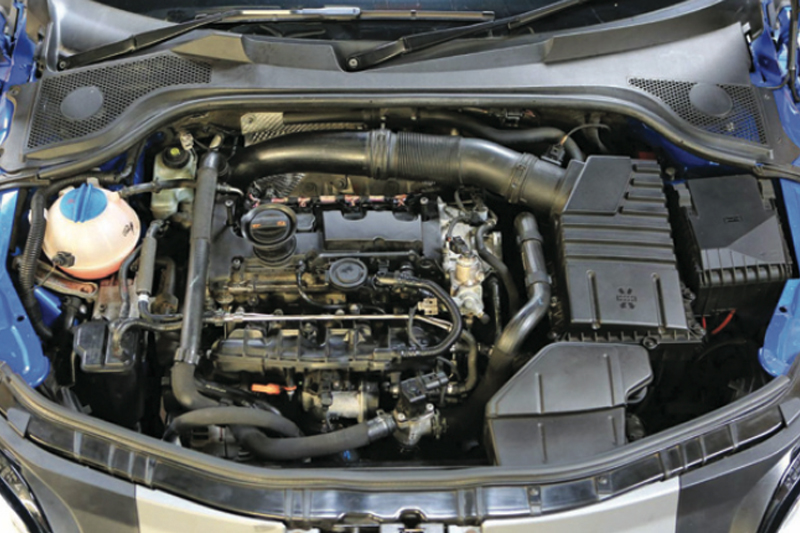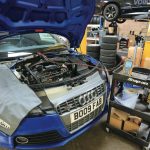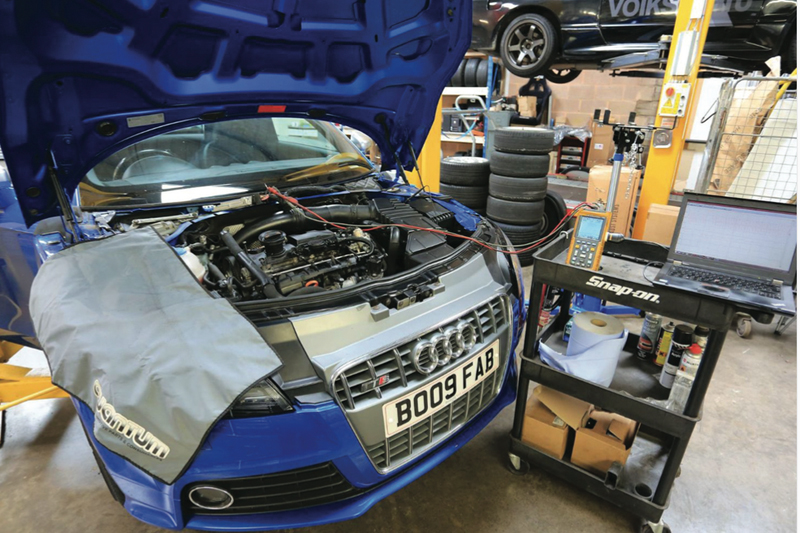This month, Joshua Jones has teamed up with Volkscraft, an Exeter-based independent VAG group specialist, to bring you his account of an interesting diagnostic dilemma involving a 2009 Audi TTS 2.0 TFSI.
In previous articles, I’ve stressed the importance of making the most informed decision possible when it comes to replacing expensive components like electronic control units. In the scenario I am about to describe, I was forced to practice what I preach. This was a good one!
A friend’s Garage, Volkscraft Exeter, was the lucky recipient of an Audi TTS, with the customer complaining of the MIL periodically illuminating, despite absolutely no physical symptoms being exhibited at all. The car had a full service history and under 50,000 miles on the clock. Obviously, the first port of call was a road test, to see if the fault would materialise. The car drove perfectly, with no signs of hesitation or misfire of any kind. After a few miles of running time on every drive cycle, the MIL would indeed illuminate, so it was back to the workshop for evaluation.
Following a visual inspection under the bonnet, which showed no abnormalities, a scan tool was connected, initially to analyse the fault code(s) that were triggering the lamp illumination, and P0300 (random misfire detected) was being stored every time the lamp came on. The VCDS data was then used to display misfire counter activity for each cylinder, as this naturally was the next port of call in an effort to diagnose.
What followed was quite odd, to say the least. If the engine was allowed to idle, absolutely no issues were encountered and the motor would quite happily tick over all day with no misfires registered. If the rpm was raised to over 1800rpm, and every time a subsequent 750rpm was added to this, however, the control unit would almost immediately begin to count misfire events in a random fashion across all four cylinders (easily seen on the VCDS screen). This was very confusing, as the engine note and refinement was not an audible concern in any way.

I will now make an effort to describe the chain of tests carried out following this discovery, which ultimately led me to my conclusion. Between my friend and I, we agreed that if the engine was indeed not suffering physical misfires, then there had to be some kind of external influence or interference taking place that emulated the conditions that the control unit looks for in order to determine misfire events. As both of us had never before analysed a misfire that wasn’t there, we decided to next look at the crankshaft sensor output in detail to establish if any visible clues were available.
Looking into the trace of the crank sensor, at the engine speeds required to trigger the counting process showed a textbook signal, with good amplitude and very little noise, even when taken at the control unit. A second trace was added from cylinder one’s coil control circuit, in an effort to see if the increase in engine speed caused by each individual firing event was visible in the crank trace when viewed in conjunction with ignition control. Even with an artificial misfire introduced, we were unable to deduce a pattern by measuring comparative delta time between peaks in the crank sensor output. This made me realise just how advanced the programming of a control unit is, for it to be able to measure these absolutely minuscule discrepancies that lead to the (normally) accurate diagnosis of an engine misfire event.
After deciding that variance in engine speed was not in fact the cause of the misfire counts, even though this completely defied logic, we needed to rule out as many other variables as possible. These included evaluating the potential effect of components with high background noise – e.g. ignition coils and injectors. The only measurable interference picked up in almost every trace taken was from the coils. This was as prevalent at idle speeds as it was at every other rpm range, so we ruled it out as a potential cause of confusion to the engine ECU.
The auxiliary drive belt was temporarily removed to rule out alternator interference and the timing belt drive line and crank pulley were inspected for their potential to cause irregular crank rotation. As the fault was present at various engine speeds, as opposed to specific ones, the peak resonance frequency outputs of the engine were also considered as a culprit, but the misfire data logging was occurring at engine speeds that ruled this out as a suspect as well.

Lastly, the ECU body itself was traced, in case any pattern of excess noise levels was present. This trace showed nothing significant enough (other than the previously described ignition coil noise) to cause concern, but the waveforms taken were wisely saved by Volkscraft as they will be a great asset when it comes to comparisons for future issues. With our list of variables being ticked off slowly but surely, we were getting closer to making the dreaded decision of control unit replacement.
The list of signs that an ECU could use to determine a misfire and log it accordingly should be very short indeed, as fluctuations in engine speed are what the computer is programmed to recognise, and clearly these fluctuations were not occurring. Even so, when making this kind of decision, the importance of understanding the engine systems (mechanical and electrical) in question and the potential effect they can have on ECU fault calculations is paramount when ruling out a cause.
With the customer’s authorisation, a used control unit was sourced, cloned by a specialist and fitted to the vehicle. Upon road test, it was clear that the issue was solved. As an added, interesting way of confirming the success of this diagnosis, the faulty control unit was reprogrammed and fitted to a luckily available test car on site. The fault prevailed on the second vehicle, even after uploading the latest software and resetting all adaptive parameters (this was also done before being removed from the original car).
I would like to thank Matt Smith from Volkscraft for allowing me to enjoy being part of this process. His skill and expertise is an asset to his (very happy) customers.











